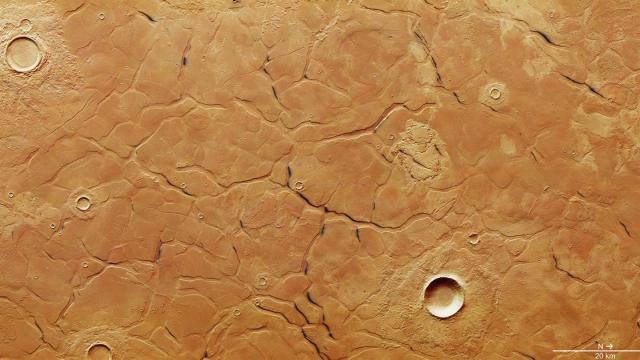Future Martian colonists, NASA just found you a reservoir. Frozen beneath a cracked and pitted region in Mars’ mid-northern latitudes lies a sheet of ice with about as much thirst-quenching potential as Lake Superior.
Satellite image of the terrain in Utopia Planitia, where scientists just discovered a vast water ice deposit. (Image: ESA/DLR/FU Berlin)
The ice, located in Utopia Planitia (pictured above), was discovered by a team of researchers led by PhD student Cassie Stuurman of the University of Texas, Austin. Analysing the data from more than 600 ground-penetrating radar scans by NASA’s Mars Reconnaissance Orbiter, the scientists have inferred the presence of an frozen, dusty water deposit spanning an area larger than New Mexico. The finding was recently published in Geophysical Research Letters.

Shallow radar data from two tracks in Mars’ Utopia Planitia region indicate the presence of ice-rich deposits. Image: NASA/JPL-Caltech/Univ. of Rome/ASI/PSI
To Mars researchers, it is not exactly surprising to find ice on the Red Planet. “There’s a lot of water ice on Mars,” Stuurman told Gizmodo in an email. “Based on outflow channels formed early in Martian history, we think Mars once had enough liquid water to cover the whole planet in a layer 100’s of metres deep.” Much of that ancient water has been lost to space, but today, vast quantities remain sequestered at Mars’ poles.
What is most surprising about Utopia Planitia, Stuurman said, is the proportion of water ice (50 to 85 per cent) to rocky material, and the relationship between ice and rock. Rather than being tightly bound to minerals, much of Utopia Planitia’s ice exists in discrete deposits. The entire ice sheet is also incredibly thick, 170m.
“This [thickness] is unprecedented for deposits of this type, and could be used to constrain climate models,” Stuurman said. In other words, on Mars as on Earth, thicker layers of ice give us a longer window into the planet’s climate history.

A vertically exaggerated view of Utopia Planitia, showing depressions that prompted researchers to look for buried ice. Image: NASA/JPL-Caltech/Univ. of Arizona
The water could also be used to slake human thirst. Indeed, several aspects of Utopia Planitia make it an attractive watering hole for future colonists. For one, the ice extends close the equator, which, in Mars’ current “warm phase” is considered the most hospitable part of the planet. The ice is deposited on flat terrain, well suited for traversing in a rover, and it’s close to the surface, covered by an estimated 1 to 10m of Martian regolith. “This deposit is probably more accessible than most water ice on Mars,” study co-author Jack Holt of the University of Texas said in a statement.
Stuurman is continuing to piece together the geologic story of the region, which is thought to have accumulated water as snow during a past ice age, when the planet was much more tilted about its axis than it is today. Understanding how Utopia Planitia formed may help us to find other deposits like it.
